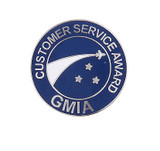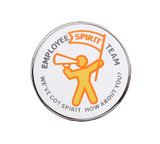Hard Enamel Lapel Pins
New Hard Enamel (sometimes called Epola) starts out the same way. But instead of powdered glass, hard epoxy enamel is used to fill the recessed spaces. This epoxy enamel gives a beautiful, high quality look
|
|
The earliest lapel pins were made using traditional Cloisonné, the ancient method of glass enameling in which powdered glass is poured into the recesses of a die-struck metal base and baked at a high temperature. The glass enamel is then sanded and polished to be flush with the metal lines that separate the colors. This gives the lapel pins a smooth and lustrous quality. Today's method, using New Hard Enamel (sometimes called Epola) starts out the same way. But instead of powdered glass, hard epoxy enamel is used to fill the recessed spaces. This epoxy enamel gives a beautiful, high quality look similar to that of the Cloisonné, but at a lower price and with hundreds of color options, compared to the very limited color options with Cloisonné. With each of these techniques the metal base can be plated in gold, silver (nickel), black, copper or brass. Great for recognition, awards or membership lapel pins. Highest, jewelry-like quality. |













